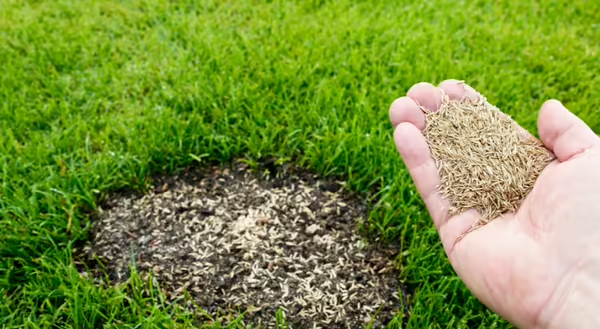
Picture this: It's the middle of summer, and you've noticed your lawn is in bad shape. You go to the garden center and see shelves full of grass seed. The store is carrying seed, so that must mean it's okay to sow your new lawn at this time, right? You purchase a bag or two, but what type of grass did you get?
Cool-season or warm-season grass - what's the difference?
Here in Central Illinois, you will most commonly find cool-season types of turf for sale. In fact, you will likely be hard-pressed to find any warm-season grass seed.
Cool-season grasses are preferred in our area and northward because it tends to stay green later into the year. As the name implies, cool-season grass grows actively in the spring and fall and will go dormant, turning a straw-colored brown during the summer. Conversely, warm-season grasses prefer the heat of summer and will only be green and thriving during June, July, and August.
The ideal time to sow warm-season grass is before the start of summer. Since this type of grass loves heat, this is the best time for establishment.
The best time to seed a cool-season lawn is the late summer to early fall. A late-season seeding of cool-season turf is more conducive to its growth cycle because it gives the lawn the fall, winter, and spring to become established before the summer heat arrives.
A late summer to early fall sowing also beats out a spring seeded lawn for a few reasons:
- Warmer soil. In the spring, the ground is cold, and germination is not as efficient. Coming out of the summer, our soils are warm offering better germination.
- Less competition. Annual weeds are the biggest problem most homeowners face with a new lawn. By late in the season summer annual weeds will have completed their lifecycle and won't return until next spring when your late-season planted lawn has more of a competitive edge.
- More food for wildlife. Not food for your lawn, but food for the birds and rodents that eat lawn seed. At the end of the growing season, the landscape is flush with seed and other goodies for wildlife. Coming out of winter there is less food, so many birds and rodents (voles, in my yard's case) will view your seed as a meal.
What if you seeded your lawn with cool-season seeds mid-summer?
Let's assume you went ahead and seeded your lawn with a cool-season mix in the middle of summer. Now, what do you do? Don't panic!
Once the seed germinates, it will likely be met with our blazing hot Midwestern summer. High temperatures are not conducive for growth, and the seedlings may give out a few days past germination even with supplemental irrigation.
The only thing that can be done at this point is adequate irrigation. Depending on weather conditions, plan to supply 1 inch to 2 inches of water every week to your lawn as it tries to establish. You could split these water applications up over a few days of the week; my preference is to deliver 1 inch of water at one time and monitor the soil. When the top few inches dry out, apply another inch. As a lawn establishes, the best practice is to do infrequent, yet deep soakings.
Be prepared to do another round of seeding in the late summer to early fall. Dates that correspond best in Central Illinois are August 15 to September 15. Adjust by a week or two depending on your latitude for Illinois residents - later in August for southern Illinois and earlier in August for northern Illinois.
A final word to the wise: Never mix warm with cool-season grass types. During any time of the year, you will wind up with patches of green and dormant grasses.
For more information, check out our University of Illinois Extension's LawnTalk, or contact your local Extension office.